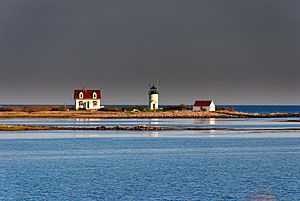Cape Porpoise, Maine facts for kids
Cape Porpoise is a small village located right on the coast in Kennebunkport, Maine. It was one of the very first English settlements in this part of Maine. The village sits next to Cape Porpoise Harbor, a deep natural harbor that is protected by more than a dozen small islands. The Goat Island Light (a lighthouse) stands at the entrance to the harbor, guiding boats safely in.
Contents
History of Cape Porpoise
People have lived in the Cape Porpoise area for a very long time, even as far back as 7,000 BCE! When Europeans first arrived around 1602, the Abenaki people lived here. Their main village was Sowocatuck, near the Saco River.
Early European Settlement
The name Cape Porpoise was given by explorer Captain John Smith in 1614. English fishermen started visiting the area seasonally around 1619. A permanent European settlement was then created in 1629. The town was officially named "Cape Porpus" in 1653 by the government of the Massachusetts Bay Colony.
Conflicts and Wars
As more Europeans settled, they cleared forests for farming. This changed the land and made it harder for the Abenaki people to hunt and live as they always had. This led to disagreements and fighting.
During a war called King William's War in 1689, Native American groups forced the settlers to leave the mainland. The settlers had to go to Stage Island until the English rescued them. English settlers left the town until 1699. The Wabanaki Confederacy, a group of Native American nations, continued to try and remove European settlers. They attacked settlers again in 1703 and from 1723 to 1727. The fighting finally stopped after King George's War, when France gave control of southern Maine to England.
American Revolutionary War Battle
During the American Revolutionary War, on August 8, 1782, two English ships, the Meriam and the Hammond, entered Cape Porpoise Harbor. They tried to capture two American ships as prizes. The English took one ship but the other ran aground. The local town militia gathered and fired cannons and muskets at the English ships from the shore.
The English burned the grounded ship. They then tried to leave the harbor, but the wind made it difficult. For several hours, the English ships slowly moved out of the harbor while under fire from the American militia. The English also tried to shoot back. More than 20 people were killed during this battle. The only American who died was Captain James Burnham, a leader in the town.
Modern History
In July 2010, the famous singer Taylor Swift filmed parts of her music video for the song "Mine" in Cape Porpoise. She filmed scenes in local restaurants, Wayfarer and The Captain's, and also by a nearby river.
Geography
Cape Porpoise village is located along State Highway 9.


